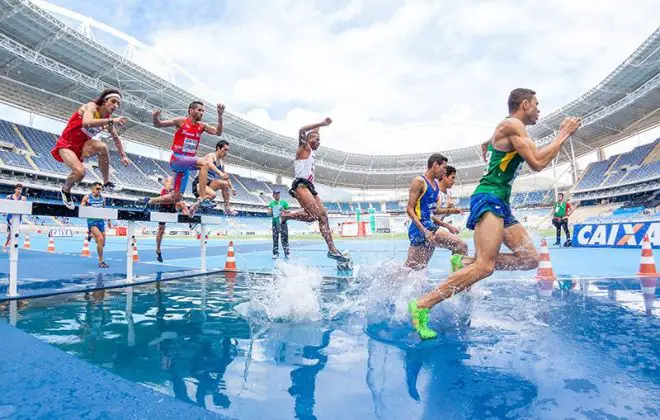Period Training – How To Optimize Training Around Menstrual Cycle
Period training – and training around menstrual cycle in particular – is a quite sensitive topic. But despite its importance, in my coaching experience I found that not every female athlete is eager (or comfortable) to discuss such personal details.
Yes, some will ask me if their training plan should be changed to accommodate their monthly menstrual cycle. Others simply skip days without prior notice. And then there are those who silently suffer through long or hard sessions and later share how they were feeling off.
There are always these debates whether men and women are the same and if the same rules should apply. Physiologically, men are simple – our hormones are relatively flat and predictable day by day. Women, on the other hand, go through hormonal changes on a monthly basis, which affects their performance, energy levels and mood.
The good news is that these changes are predictable and in this post I’ll share how to plan and train around menstrual cycle to maximize endurance training benefits.

Menstrual cycle and exercise performance
The truth is, core principles behind endurance training and exercise performance are the same across all sports and athletes. But there are always individual nuances that can affect the planning, like lifestyle habits, specifics of a particular sport and, yes, gender as well.
There are a few patterns I’ve discovered during my coaching practice – some through talking with my female athletes (especially my wife) and some by analyzing training data.
The obvious one is that a few days prior and the first couple of days of the cycle women, let’s say, don’t feel their best. Fatigue, headaches, low energy, irritability, gastrointestinal problems, cramps or even pain in the lower abdomen are just some of the physical and emotional discomfort symptoms. And while for some athletes the start of a menstrual cycle can be life-disturbing, others experience less symptoms and treat it as mild discomfort.
Training-wise, this is the time to adjust the week to reduce stress on the body when it’s already under pressure. Move some key workouts to another day and change how the week looked like to allow for more recovery. Not necessarily skip the week, because often doing some physical activity can reduce or even eliminate some of the symptoms (more on that below).
But there are other patterns as well. For example, following the days of discomfort there’s usually a period of high energy and productivity. That is when I realized, that
Period training is not only about managing symptoms. It means considering the entire menstrual cycle and planning the month accordingly.
To become a better coach and ensure that my athletes are performing to their full potential throughout the month, I needed to understand how the hormones affect female athletic performance.

The Resilient Athlete
A Self-Coaching Guide to Next Level Performance in Sports & Life
Are you aiming to become a resilient athlete who is able to withstand any pressure? Be able to jump on any opportunity? Take any challenge life throws at you head on?
Then this book is for you.
Learn moreTraining around menstrual cycle, nutrition and ‘period friendly’ workouts
So, how to plan for females training around menstrual cycle?
First of all, in an ideal case, the length of a menstrual cycle is predictable. It varies from female to female, but on average tends to be 28 days. Tracking it with an app can make it easier to follow and share with the coach who can then decide what would be the best training approach at a given phase in the cycle.
Having a regular menstrual cycle is an indicator of a healthy hormonal balance. It’s worrying that sometimes women, coaches and even doctors ignore or don’t pay enough attention to it. An estimated ~25% of female athletes report chronically missing their period, which can come at the expense of female health later in life. Unfortunately, the research in the area of female athletic performance is relatively new and is not widely applied.
The menstrual cycle
The menstrual cycle can be broken down into two distinct phases – the follicular phase (days 1-14) and the luteal phase (days 15-28) – and the two primary hormones involved are estrogen and progesterone. These and other hormone levels affect all processes in the body. Most notably for an endurance athlete, metabolism (including carbohydrate and fat oxidation), blood plasma volume and thermoregulation (how we deal with heat stress).

Planning your period training helps to take into account these changes and can improve adaptations from endurance training. In other words, learning to work with the body and prepare for the changes, instead of reacting to them.
Besides training, nutrition also plays an important role in optimizing results and managing symptoms. In particular,
Eating for the right cycle phase can help to stabilize blood sugar, improve sleep and energy levels and even reduce PMS symptoms.
Female body needs will change throughout the menstrual cycle and trying to maintain the same diet might not be optimal.
Period training: follicular phase
Day 1 of the menstrual cycle is when menstrual bleeding starts. Inflammation is high, so it’s best to take these few days easy and focus on recovery activities. The upcoming days (4 to 6 on average), however, are very individual. Some athletes are unable to train due to severe cramps in the lower abdomen, while others can continue their training as normal. In fact, those who can tend to perform better.
Generally, the follicular phase is a more predictable part of the cycle. Especially its middle part – the hormone levels are low, there’s more blood plasma volume and the body is able to oxidize fats better (thereby needing less carbohydrates). That results in higher energy levels, more stable blood glucose, better recovery and – often – higher motivation.
All of this means that female athletes can tolerate more intensity and training load during the first half of their menstrual cycle. Moreover, research also suggests that strength training during follicular phase results in better gains in muscle strength and size.
So, for more effective training around menstrual cycle aim to schedule harder sessions during its first half. Right after the period. That might include:
- High intensity intervals (like 6x4min in Zone 4 or 12x1min in Zone 5) or sustained threshold sessions (like 3x8min FTP builds on the bike or 3x3K runs at Zone 4)
- Particularly long sessions (like 3+ hour rides or 1:30+ hour runs) with or without blocks at race intensity
- Strength training with heavy weights (i.e. over 60% of 1RM) or until exhaustion
- Fasted training (i.e. running or cycling on empty stomach)

Training during ovulation
The hormone levels remain low until ovulation which is caused by a surge in estrogen and luteinizing hormone (LH) levels (around day 12). That spike in estrogen contributes to increased muscle strength and quicker recovery from exercise-induced stress. So, high intensity interval (HIIT) sessions and VO2max workouts might seem easier to complete. It’s also a great time for time trials or benchmark test to re-align the zones.
However, research suggests that estrogen decreases stiffness in tendons and ligaments (unlike bone and muscle where it improves their function). This means that higher estrogen levels during ovulation carries an injury risk, so make sure to spend extra time on joint warmup.
Nutrition during follicular phase
You might feel that you want to eat a little less during this phase and that’s ok. Many female athletes report having fewer food cravings following their period – that is thanks to a more stable blood sugar levels.
At the start of the menstrual cycle the hormone levels go down a lot and it’s important to support their natural production in the body. For that dietary fat is very important, because every hormone is made of it (and protein). Moreover, as the body relies more on fat metabolism during the follicular phase, not consuming enough fat will likely lead to lower energy and might slow down all other processes. So, aim to consume plenty of ‘good fats’ (those found in avocados, nuts & seeds, oils) in the first half of the menstrual cycle.
Additionally, the nutritional goal of follicular phase is to help create new blood and replenish iron stores, as both were taxed during menstruation. For that red beets, apples, leafy greens (especially spinach), kidney beans.
Read also: Top 10 Endurance Athlete Diet Mistakes And How To Avoid Them
Period training: luteal phase
Following ovulation, progesterone levels rise (alongside estrogen) to prepare the lining of the uterus for egg implantation (and potential pregnancy).
This is the high hormone phase and is a more challenging part of the cycle. High levels of estrogen and progesterone lead to an increase in the core body temperature, which results in higher energy expenditure and elevated resting heart rate. Moreover, during the luteal phase of the menstrual cycle blood plasma level drops by an estimated 8%, making the blood ‘thicker’ and reducing its oxygen carrying capacity. So, endurance performance is impaired.
Progesterone is a catabolic hormone, which impacts recovery rate, muscle-building capacity and reduces performance at higher intensities.
All of the changes above affect women’s ability to train and decreases time to fatigue. Not to mention the added emotional pressure.
During this time female athletes can still put in solid blocks of training. However, since endurance performance is impaired, it’s best to reduce the intensity a little and focus more on longer duration aerobic-type workouts with additional recovery time. For example:
- Fartlek sessions (i.e. 10x1min in Zone 4) instead of interval sessions at VO2max intensity
- Longer tempo runs (30-60min Zone 3 efforts) instead of threshold-building intervals
- Long easy rides (or runs) without race pace efforts
- More recovery and/or aerobic workouts (sessions in Zones 1 – 2) with focus on good form. Ideally, paired with easy drills
- Base strength sessions instead of workouts with heavy loads. Also, sessions with particular focus on mobility, core and stability

Late-luteal phase – preparation for the period
Unless there’s no egg implanted, towards the end of the luteal phase (about 5 days before the period) both estrogen and progesterone levels start to drop in preparation for the next cycle. This change triggers physical and mental symptoms (pre-menstrual symptoms or PMS), such as anxiety, mood swings, as well as further decrease in performance and energy levels.
This is the best time to support your body and take a recovery week. Reduce the overall volume by 20-30%, include an extra rest day and – if you feel the body needs it – reduce intensity to Zones 1 and 2 (but do keep moving and exercising). Focus on yourself – sleep more, meditate, write in a journal and practice self-care.
Read also: Restorative Sleep And The Science Behind Athlete’s Best Kept Secret
Nutrition during luteal phase
In a high hormone phase blood sugar is less stable and the body relies more on carbohydrates, which taxes glycogen stores and affects energy levels. Female athletes may need to consume more carbohydrates before and during the session to maintain similar power and intensity as in a low hormone phase. Outside training aim to consume complex carbs (whole grains, beans, legumes, vegetables) to stabilize blood glucose levels throughout the day. Doing so can also help reduce mood swings.
Consuming extra protein during the luteal phase can help to support recovery, as the body is more tired and injury prone. However, try to limit meat & dairy towards the end of the phase, because besides the fact that it takes the body longer to process and absorb those (plus requires more energy), the hormones found in those products can aggravate PMS symptoms. For the same reason it’s a good idea to avoid stimulants (like caffeine).
In the second half of the cycle the body temperature tends to be 0.5°C to 1°C higher than during the low hormone phase. Because of that and lower blood plasma volumes women need to pay closer attention to hydration throughout the entire luteal phase. That includes both fluid and electrolyte intake, as progesterone facilitates sodium loss.
DON’Ts of luteal phase
During the luteal phase there’s an increased physiological pressure on the body. That needs to be taken into account for more effective period training. Otherwise, female athletes risk pushing themselves too much, facing training plateaus or even suffering from overtraining & burnout. Here are a few tips to prevent that:
- Don’t do fasted training during the second half of your menstrual cycle. Every fasted workout increases the workload and can undermine other sessions. Aim to fuel before (and during) training or reschedule your day to avoid training first thing in the morning.
- Don’t push yourself if you’re feeling flat. Instead, lower intensity by a zone and carry on with the program.
- Don’t train to exhaustion. This will result in accumulated fatigue and will require more time to recover from, thereby impairing the high quality training you can do during the upcoming follicular phase.
- Don’t restrict calories by too much or try to lose weight aggressively. The body is under pressure and needs energy for recovery. There’s also a tendency to ‘hold’ water, so the scales will not be precise anyway.
Race performance during the menstrual cycle
While you can move your training around the menstrual cycle, a planned event or race date is usually fixed.
For optimal endurance performance it would make sense to be in a low hormone phase to benefit from increased blood plasma volume, stable blood glucose and better thermoregulation. Some pro athletes and literature even suggest that onset of the period is the time for that. In a way, when you feel the worst, you perform the best.
The bottom line is, it’s all very individual and depends on when an athlete feels the best. After all, navigating a race with menstrual bleeding or premenstrual symptoms (bloating, irritability, etc.) can be very inconvenient. Listen to your body and try to find your own pattern – when do you feel the strongest and most comfortable.
What’s next?
That’s a simplified overview of the effects of the menstrual cycle on exercise performance. But I believe it’s enough to conclude that it’s a lot of changes (and stress) to go through every single month. Period training is NOT simply about managing the pain and dealing with PMS symptoms for a few days before getting back to ‘normal’.
There are many resources available that split the phases further and provide more detail. But personally, I found that it’s best to hear from someone who deals with it on a daily basis. Laura Philip, world’s top long distance triathlete, has published a series of videos explaining in depth what happens in a female body and how it affects performance in a female body. Don’t forget to switch on English subtitles – the audio is in German.
Andrejs
Related Posts
1 Comment
Leave a Reply Cancel reply
GET A FREE TRAINING PLAN
Subscribe to my email list and get access to a free 4-week “back in shape” training plan
You’ll also get two full-body strength sessions and some other goodies!

How did I get here?
Hey there! My name is Andrejs and I am here to inspire, entertain and get you fit for any adventure.
I went from being an over trained pro athlete to an endurance coach sharing how to listen to your body and live life to the fullest.
Traveling, new sports & activities brought new meaning to my training and made it much more effective, fun and enjoyable. And I'm here to help you do the same.



Great job on your blog! Your content is very engaging and informative.
I appreciate the effort you put into creating quality content that is both helpful and interesting. Keep up the good work! Your blog is sure to continue to attract and retain readers.